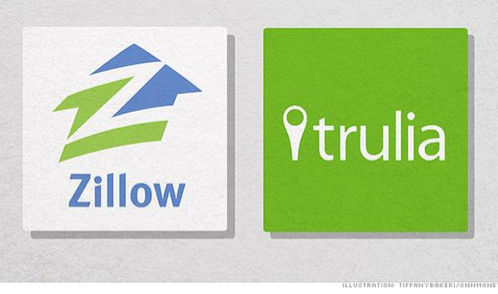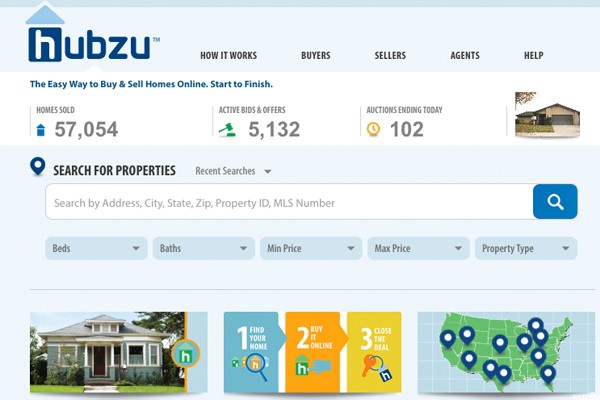Zillow V (Z TRLA)
Post on: 6 Июль, 2015 No Comment

If you’ve ever done research online to buy or sell a home or to see how much your home might be worth, you’ve probably used Zillow (Z ) or Trulia (TRLA ). What’s interesting is that while these two sites are quite similar – both sites share free real estate market data – you probably haven’t used both. The July 2014 press release announcing the two publicly traded companies’ planned 2015 merger stated that about half of Trulia’s visitors weren’t using Zillow and about two-thirds of Zillow’s visitors weren’t using Trulia. Are you missing out? Let’s take a look at what each site has to offer.
Finding Homes for Sale
If you want to look at listings of homes for sale, you can do so on both Zillow and Trulia. Both sites display “featured” homes; these are listed by agents who pay to have their listings appear at the top of the search results and to have their agent profiles displayed alone instead of alongside those of competing agents. Both sites also display county public records on properties, but sometimes these records aren’t accurate.They might say a home has one bathroom when it has two, or that it’s 1,700 square feet when it’s 1,900. Both sites let homeowners correct facts about their homes online, but getting public records fixed requires contacting the county assessor’s office.
Both sites let you limit your search to homes within a specified price range and sort search-result listings by newest, price, number of bedrooms or bathrooms and square footage. Other sorting criteria apply to only one site or the other.
– Zillow: year built, lot area, Zestimate
– Trulia: price-reduced date; dollar amount or percentage, price per SF; Transit Score; number of photos; popularity
If one of these unique sorting criteria is particularly important to you – say, you really want a newer home, or you really value living near public transit – it might make sense to favor one site over the other. Both sites display Walk Scores and ratings of nearby schools from GreatSchools.org with individual listings. Trulia also displays neighborhood data, such as crime statistics, public transit routes and amenities. Both sites display trends in area home prices. (Learn everything you need to know about buying a home in How to Buy Your First Home: A Step-by-Step Tutorial .)
Despite the wealth of information both sites offer, you may not want to use either site as your primary resource if you’re actively searching for a home. A 2012 study by competitor Redfin. which calls itself “a customer-first real estate brokerage,” found that out of 6,401 home listings in 33 zip codes from 11 metro areas, Redfin and local brokerage websites displayed 100% of agent-listed homes for sale, while Zillow and Trulia were missing about 20% of these listings. Redfin also found that Zillow and Trulia tended to lag by about a week in displaying new listings. By that time, a home could have received an offer and gone under contract. What’s more, about a third of properties shown as active on Zillow and Trulia were no longer for sale, Redfin’s study found.
Estimating Property Values
There are many reasons why you might want to see an estimate of a property’s value:
– You’re moving, and you want to get an idea of which neighborhoods are in your price range.
– You’re thinking about writing an offer on a home, and you want to know if the listing price reflects the home’s market value so you don’t overpay. (Before you make an offer, read 7 Must-Have Real Estate Contract Conditions .)
– You’re thinking about selling, and you want to know how much money you might get.
– You want to refinance, and before you spend several hundred dollars on an appraisal, you want to get an idea of whether your home will appraise high enough to allow refinancing.
– You’re nosy and want to know how much your coworkers, your friends, and your relatives spent on their houses.
Both Zillow and Trulia provide estimates of property values, though Zillow is better known for this feature and even has a catchy name for it: a Zestimate. But can you rely on these numbers?
“I suggest that consumers use both websites and keep in mind that they are only rough estimates on many levels,” says Elysia Stobbe, branch manager and loan originator for NFM Lending in Jacksonville, Fla. “Sometimes they don’t take into account all the upgrades or changes an owner has made to a house,” she says. “We use the value of both Zillow and Trulia to get a ballpark idea if it makes sense for our borrowers to apply for a refinance, but the appraisal is the value that lenders use, not estimates on these websites.”
To its credit, Zillow is forthcoming about how accurate its estimates are. shows a range of possible high and low values when you click on a particular home, and uses a star rating system to show users how confident it is about Zestimates overall in various metropolitan areas.
Trulia Estimates tend to differ from Zestimates, and Trulia also states that some of its estimates are more accurate than others. but this disclosure isn’t as apparent when looking at individual listings. Trulia encourages users to request a report on any home whose value they’re interested in, which puts you in touch with a local real estate agent. Both sites make it easy to see comparable listings and recently sold homes near a specific property.

Estimating Monthly Payments
Both Zillow and Trulia show prospective homebuyers the estimated monthly mortgage payments for the listings they look at. The two sites estimate mortgage payments differently, however.
For example, for a California home listed at $469,900, Zillow provided a monthly payment of $1,691 based on a 20% down payment and 30-year fixed-rate mortgage. It pointed out that estimated taxes and insurance of $309 per month were not included, which would bring the total to $2,000 a month. Zillow doesn’t display the interest rate assumed to calculate the principal and interest payment; it only links to another page where you can get lender interest rate quotes based on your credit score.
For the same property, Trulia provided a monthly payment of $2,233, also based on a 20% down payment and 30-year fixed-rate mortgage, which the site broke down as $1,723 in principal and interest at 3.67%, $391 in property taxes and $117 homeowner’s insurance. Trulia will also take you to a page like Zillow’s where you can see lenders’ advertised rates.
The monthly payment estimates assume “great credit, 20% down and don’t take into account monthly homeowner’s association or condo fees,” Stobbe says. “Neither website explains this to the consumer. I spent 30 minutes with a client on Sunday reviewing the difference between the monthly payment on Zillow versus what her actual monthly payment would be including principal and interest, 5% and 20% down payment options, property taxes, homeowners insurance and condo fees.”
The interest rate you could get will depend on the lender and your credit score. If you don’t have a 20% down payment, private mortgage insurance will be another monthly expense. (For more, read Why do I need to pay private mortgage insurance (PMI)? )
Further, some properties are located in high flood hazard areas, meaning the lender will require you to carry flood insurance. (See Understanding Lender-Required Flood Insurance to learn more.)
In addition, neither company’s property tax estimate tells you what you will end up paying in taxes when the property changes ownership, which could be significantly more. Also, insurance costs can vary by hundreds of dollars depending on which insurance company you choose, the home’s estimated replacement cost (which is less than the purchase price because homeowners insurance doesn’t cover the land), and the deductible you select. Neither Zillow’s nor Trulia’s monthly payment estimates are likely to reflect what you’ll actually end up paying. You’ll need a real estate agent, a mortgage lender and an insurance agent to figure it out. (To learn more, see Your Property Tax Assessment: What Does It Mean? and Taking Advantage of Property Tax Abatement Programs .)
The Bottom Line
Subject to regulatory approval, Zillow and Trulia will merge later this year, so don’t be surprised if the sites become more similar. However, the two sites will remain separate: Zillow will focus on “the full lifecycle of owning and living in a home: buying, selling, renting, financing, remodeling and more,” while Trulia will retain a narrower focus on the home-search process. Both companies are interested in connecting real estate industry professionals with consumers and define themselves as “primarily media companies, generating the majority of revenue through advertising sales to real estate professionals.” Keep that in mind, whichever site you’re using.














